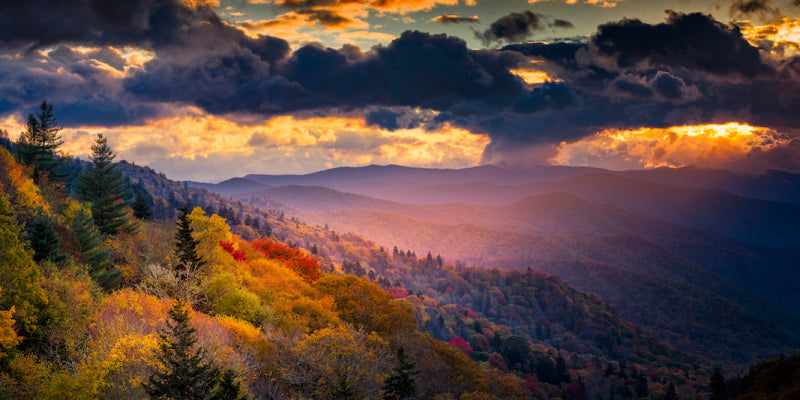Established in 1934, Great Smoky Mountains National Park is America’s most visited national park. The 800 square miles of old growth forest and ancient mountains straddle the border between Tennessee and North Carolina, part of the Blue Ridge and Southern Appalachian Mountain chain. The park is accessed from Gatlinburg, Tennessee, and Cherokee, North Carolina.
So what are some Great Smoky Mountains National Park activities?
 Celebrate Mother Nature’s Diversity
Celebrate Mother Nature’s Diversity
In recognition of the park’s unique natural resources, the United Nations has designated Great Smoky Mountains National Park as an International Biosphere Reserve and a UNESCO World Heritage Site. Nearly 95 percent of the park is forested, which can make it challenging to spot the 17,000+ species of plants and animals that call the park home. Amazingly enough, scientists speculate that over 80,000 additional, unidentified-as-of-yet, species may reside in the park!
The Great Smoky Mountains are among the oldest mountains in the world, formed 200-300 million years ago. The ranges have not experienced a lot of climactic or geological changes, making them a popular home for migrating species. The park has sixteen mountains that exceed 6,000 feet, with elevations ranging from 875 to 6,643 feet.
See Black Bears and Salamanders Thrive Great Smoky Mountains National Park is one of the largest protected areas in the eastern United States for black bears. Approximately 1,500 bears live in the park. That’s two bears per square mile!
Great Smoky Mountains National Park is one of the largest protected areas in the eastern United States for black bears. Approximately 1,500 bears live in the park. That’s two bears per square mile!
The park is also home to:
- 100 species of native trees
- Over 1,500 flowering plant species
- More than 200 species of birds
- 66 types of mammals
- 67 native fish species in over 700 miles of streams
- 39 varieties of reptiles
- 43 species of amphibians
- 30 salamander species, making the park the “Salamander Capital of the World.”
Hike Andrews Bald
This moderate, 3.5 mile round trip hike climbs almost 900 feet to the highest grassy meadow in the Smokies at 5,920 feet. Wind along the creek bed and perch atop a treeless viewing plateau bursting with spring wildflowers or fall foliage. From there you’ll enjoy panoramic views of the southern Smokies.
 Bike Cades Cove
Bike Cades CoveThe rich history of southern Appalachian mountain culture is alive in Great Smoky Mountains National Park, thanks to the large collection of over 90 historic log structures. Cades Cove is an 11-mile, one-way loop that circles a broad, lush valley. Here you’ll find the largest variety of architectural restoration and preservation in the park.
While you can drive the loop, the road is open only to foot and bicycle traffic until 10:00 a.m. every Saturday and Wednesday morning from early May until late September. Rent a bike at the Cades Cove Campground Store and pedal past houses, churches, schools, mills, and barns from the 1800s. Grab a self-guiding tour booklet at the entrance to the loop road to get the inside scoop on the previous human inhabitants of the faithfully restored structures.
 Drive Roaring Fork
Drive Roaring Fork
The narrow, winding, Roaring Fork Motor Nature Trail passes along one of the park’s largest and fastest flowing streams. The 5.5-mile-long, one-way, loop passes through old-growth forests and more impeccably preserved log cabins and historic buildings.
Very close to the Motor Trail entrance you’ll find trailhead access to Rainbow Falls, Grotto Falls, and Place of a Thousand Drips, three of the park’s most popular waterfall destinations.
Where to Sleep
While the communities surrounding the national park offer a large variety of lodging choices, there are no motels or rental cabins inside the park. With one exception: Le Conte Lodge.
The highest guest lodge in the eastern United States at 6,400 feet, Le Conte is only accessible by hiking. You’ll need to hoof it up one of five trails, ranging in length from 5.5 to 8 miles. Some say the views and ambience are well worth it!
Great Smoky Mountains National Park offers 10 campgrounds with a total of 1000 sites, including options such as backcountry and horse campgrounds.
The National Park Service provides a great Smokies Trip Planner, a mobile app, and online issues of the park’s newsletter. You’ll find everything you need to motivate you to be one of the ten million annual visitors to the park!



Share:
12 Lost Cities to Visit
10 Free Activities in Washington, DC